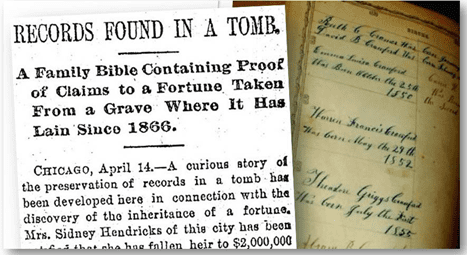Over the past 50 years I have heard of many ways to source and document our ancestors.
Genealogists will “dig up” all types of sources but the solution that the Phillips family used has to be the most unusual.
I recently came across this, the most unusual genealogy sourcing story I have ever heard of. I found it in the Plain Dealer (Cleveland, Ohio), 15 April 1891, page 1.

In 1891 the Phillips literally dug up their Family Bible that had been buried in the grave of a niece 25 years earlier.
This unusual story begins with Isaac Phillips (1766-1834), who was born in Easton, Massachusetts. He left his hometown in 1813 and moved to the South where he was “engaged in the slave trade and accumulated an enormous fortune.” He kept his money—over $5 million at the time—at the Manhattan Bank of New York.
Isaac died in 1834, “his wife and only child having previously died.” For the next 70 years his relatives tried to prove their right to the fortune Isaac left behind. They had a lot of difficulty in tracking and documenting their genealogy and finally determined that the Family Bible had the answers.
But there was a problem: the Family Bible was buried in a cemetery. It seems that it was buried in the casket along with Isaac’s niece Susana Phillips, who died 4 June 1866.
The money was still safely in the bank, accumulating interest all the while. It was now worth more than $6 million—so the family secured permission to exhume Susana’s body and remove the Family Bible.
When they opened the grave the Family Bible was found and, although a little decayed, the family history “record [was] still perfectly legible” and gave them the information they needed to prove their genealogical connection and claim the family fortune.
Moral of the story: Keep an accurate and complete family history and preserve your documentation, like Family Bibles, that prove the record.
